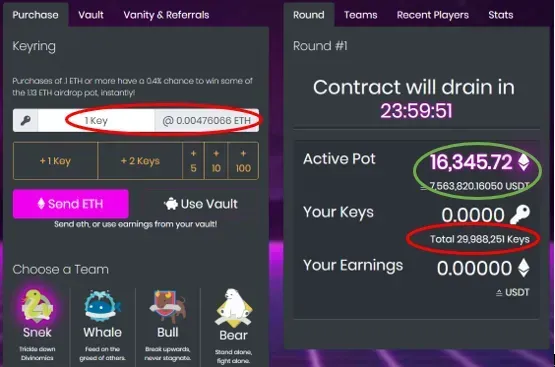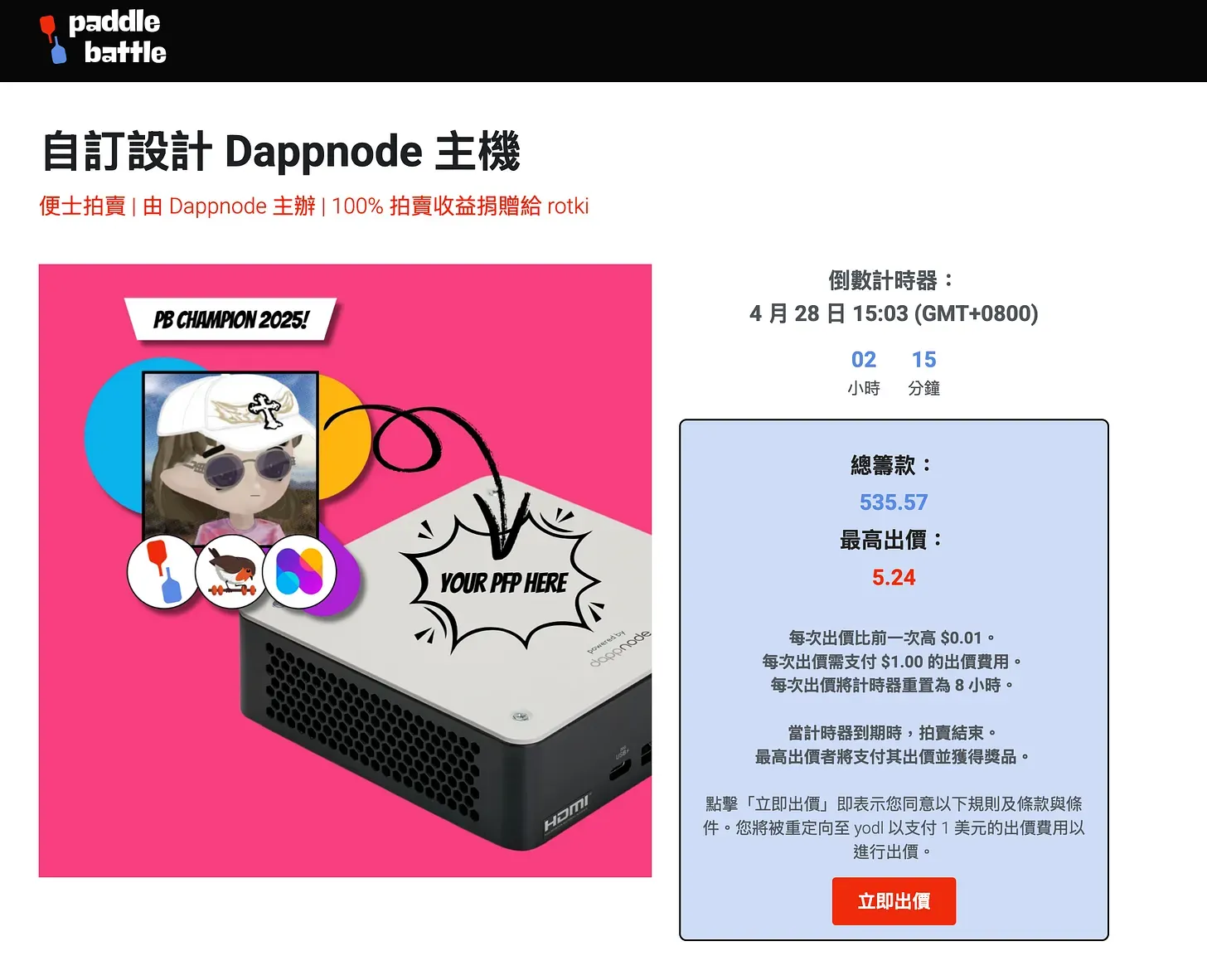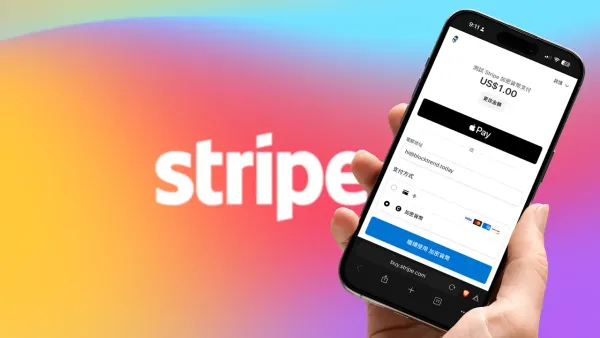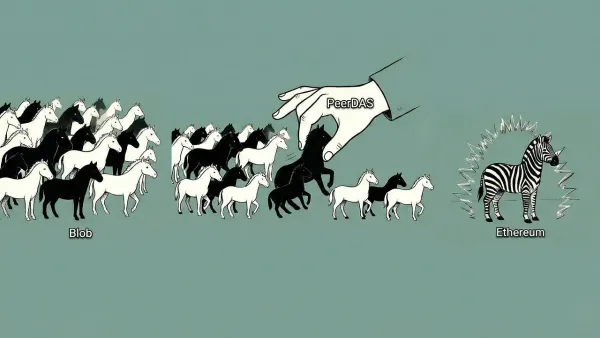Fomo3D Returns! A Game-Theory-Driven Charity Auction: Paddle Battle

GM,
This week’s podcast is on pause, and Thursday’s Labor Day means no new issue—so let’s jump straight in. Can you believe that an Ethereum mining machine originally priced at NT$70,000 is now up for grabs for less than NT$200?
A brand-new Dappnode mining rig is currently in the final countdown of a charity auction on the Paddle Battle platform. At the time I’m writing this article, the highest bid is just $5.24 USD—and there are only a few hours left before the auction ends! This article will show you how to score a bargain.
The Return of Fomo3D
Back in 2018, a blockchain gambling game called Fomo3D took the crypto world by storm. The rules were simple: anyone could place a bid to “buy a key,” and the last bidder standing would win the entire prize pool accumulated by all previous participants. The auction countdown was set to 24 hours, but every new bid added 30 seconds to the timer. The game eventually ended a month later. The winner had only spent 0.8 ETH—and walked away with a whopping 10,469 ETH. Talk about hitting the jackpot!

Fomo3D tapped into everyone’s Fear of Missing Out (FOMO). When you saw the countdown drop to just 5 seconds, who could resist the dream of striking it rich? Fomo3D was one of the most well-known on-chain games in Ethereum’s early days. But eventually, people realized that the order of Ethereum transactions isn’t determined by how fast you click—it’s controlled by miners who decide the sequence 1 2 of transactions. Once people understood they couldn’t beat the miners, Fomo3D faded into history.
Now, the charity auction platform Paddle Battle has revived Fomo3D’s game mechanics with a few adjustments—this time, the auction item is a Dappnode Ethereum mining rig that lets you become the miner!
Paddle Battle: Charity Bidding War
A “paddle” is what bidders raise during traditional auctions to signal they’re placing a bid. When bidding heats up and paddles are flying, it looks just like a battle—hence the name Paddle Battle.
The Dappnode currently on auction is something I’ve long wanted to buy, but could never justify the cost—until now. It’s a dream machine for staking, built to be plug-and-play. Just plug it in, connect to WiFi, deposit your tokens, and you can start earning ETH staking rewards. It boasts three major advantages:
- Easy to use: A graphical interface and full video tutorials make it simple to set up an Ethereum node with just a few clicks.
- Super energy efficient: It consumes only 15W to 25W—about the same as a small electric fan. Even running 24/7, your electricity bill won’t skyrocket.
- Decentralized: By running your own Ethereum node, you earn staking rewards and help decentralize the blockchain network.
I first entered the crypto space in 2017 by mining. Back then, people were scrambling for high-end GPUs, building their own rigs, and becoming Ethereum miners. I still remember the shock of receiving my first electricity bill—it was so high it had an extra zero.
After Ethereum’s historic Merge upgrade in 2022, the energy-hungry PoW mining model became obsolete. Dappnode is a miner for the PoS era, equipped with 64GB of RAM, 4TB of SSD storage, and pre-installed consensus and execution layer clients. The electricity cost is so low it’s negligible, and all ETH staking rewards go directly to you—no reliance on third-party providers like Lido, and no risk of those services being hacked. So when I saw the Paddle Battle bid price was this low, and only a few hours remained, I couldn’t resist and made a bid.
Then I started reading the rules… and realized: ah, I got played!

The bidding rules for the Dappnode auction are similar to Fomo3D. Each bid requires paying a $1 "bid fee"—non-refundable! Yet every new bid only raises the winning price by $0.01, and the countdown timer resets to eight hours. After reading the rules, I immediately realized I was caught in a dilemma.
You might think the smartest move is to wait, right? After all, the Dappnode is worth NT$70,000 (over $2,000), and the current price is just $5. It makes sense to hold off, let others pay the $1 bid fee to slowly push the price up, and only pay attention once the auction nears the end or approaches your personal price limit. But if everyone acts this “smart,” the 8-hour countdown might quietly run out, letting some lucky bidder walk away with the miner for $6.
So, is “staying at the table” a better choice? Not at all—it’s an even bigger trap. Not participating might just leave you with a bit of regret. Actively participating means losing money and regretting it. Every bid you place costs you $1 outright, yet the final price only increases by a cent, and the timer resets again and again. There’s no end in sight.
Paddle Battle is a cleverly designed auction game that exploits our human instincts—our craving for a good deal and our fear of missing out. No matter what decision you make, it feels like the wrong one. The best strategy is probably to “cut your losses”—or to simply not know any of this. But unfortunately for you, now you do know 😂
Let’s go further. Suppose the Dappnode eventually sells for half-price—$1,000—and a new bid comes in every time the countdown hits 4 hours. That would result in around 100,000 bids, or $100,000 in bid fees! But in that case, the auction wouldn’t end for another 46 years. If you think there’s no way the bidding could drag on that long, you’re falling into another trap: if the price stays far below $1,000—say, $100—how could you not participate in such a good deal?
Even if it ends at just $100, it could still generate 10,000 bids. A $2,000 product creating $10,000 in “bid fee” revenue—that’s the genius of Paddle Battle. And here's the kicker: Paddle Battle isn’t pocketing that $10,000. It’s donating 100% to Web3 public goods projects, giving everyone a perfect excuse to “cut their losses” with pride.
An Excuse to Cut Your Losses
When people don’t win a charity lottery, they often comfort themselves by thinking, “At least the money went to a good cause.” This is the classic coexistence of self-interest and altruism. Paddle Battle captures this essence and has developed a variety of auction mechanisms around it.
In the example from this article, the mining rig was donated by Dappnode, with all bidding fees designated to be donated entirely—100%—to Rotki, a public crypto asset dashboard project. For the recipient, this donation might be just a trickle of funding. But for the donor, it could become a high-profile move. Some participants may have never even heard of Rotki—they’re simply focused on winning the Dappnode miner at a bargain price.
This clever use of people’s self-interest ends up producing a win-win outcome. The platform also offers other auction formats, such as the All-Pay Auction, where every bidder pays regardless of whether they win, and the Sealed-Bid Auction, which uses cryptographic methods to fuel strategic uncertainty and second-guessing among participants.
Unlike public funding platforms like Gitcoin or Giveth, which focus more on efficiently allocating resources to the right people and emphasize the value and meaning of supporting specific projects—thereby appealing to people’s altruism—Paddle Battle takes a different approach. It doesn't seek out selfless donors. Instead, all it needs is something cool that everyone wants, paired with a set of irresistibly engaging rules, to tap into one of humanity’s most primal urges: “I want to win!” and “I want that thing!”
That’s what I find most fun about Paddle Battle—it makes self-interest and altruism no longer mutually exclusive. People might join the auction simply for the thrill and uncertainty of the process, but their actions end up supporting public goods all the same. It transforms supporting public goods from a deliberate act of charity into a natural byproduct of a fun game. I look forward to the day Paddle Battle features auctions for items that, like NFTs once did, break out of the crypto niche—maybe a year’s supply of popcorn chicken, a share of TSMC stock, or even standby travel perks from an airline.
I strongly agree with Paddle Battle’s product design philosophy of prioritizing “fun” and appreciate how it uncovers existing, ready-to-use mechanisms that never quite fit into traditional auctions. After all, who would play a game at a physical auction where each bid only increases the price by $0.01, and the timer resets to 8 hours every time? Even if you win, all you get is a product worth a few hundred or thousand dollars. It just wouldn't be worth it.
But in the digital world, those limitations disappear. Online auctions can run 24/7, and bidding takes just a few clicks. Paddle Battle even offers a helpful Telegram bot that notifies you when an auction is nearing its end, saying: “Time to place your bid!” In an ecosystem where most projects lack innovation, essentially having nothing substantial besides tokens, seeing something like Paddle Battle—so deeply human-centered and digitally savvy—rekindles a bit of hope for blockchain applications.





